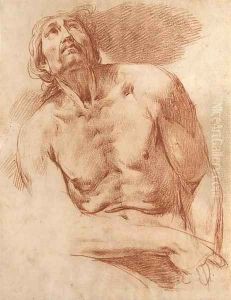Carlo Donelli, Il Vimercati Paintings
Carlo Donelli, better known as Il Vimercati, was an Italian painter of the Baroque era, born in 1615 in Crema, a small yet culturally vibrant town in the Lombardy region of Italy. His nickname, 'Il Vimercati,' derived from his family's noble lineage, indicating a status that was somewhat rare for artists of his time, who often came from more modest backgrounds. Despite the prestige associated with his family name, Donelli dedicated himself to the pursuit of art, a testament to his genuine passion and commitment to his craft.
Il Vimercati's artistic journey began in his hometown, but his talent soon necessitated travels to more prominent art centers of Italy, including Rome and Bologna, where he was exposed to the burgeoning Baroque movement. This period was characterized by dramatic use of light and shadow, a deep sense of movement, and an emotional intensity that differed markedly from the calm rationality of the Renaissance. Influenced by the works of Caravaggio and the Carracci brothers, Donelli developed a style that embraced the Baroque's theatricality but maintained a certain restraint, perhaps a reflection of his Lombard heritage.
Throughout his career, Il Vimercati specialized in religious and historical paintings, infusing his works with a palpable spiritual intensity and a meticulous attention to detail. His compositions often featured dramatic narratives, rendered with a vivid realism that brought biblical and historical figures to life for his contemporaries. Despite his considerable skills and the quality of his work, Donelli never achieved the same level of fame as some of his Baroque counterparts. This relative obscurity might be attributed to his spending a significant portion of his career in smaller Italian cities, away from the major art markets of Rome, Florence, and Venice.
Carlo Donelli, Il Vimercati, passed away in 1679 in his hometown of Crema. His legacy, though not as well-known as that of other Baroque masters, is preserved in the churches and galleries of Lombardy, where his works continue to be admired for their emotional depth and technical precision. In recent years, there has been a renewed interest in his oeuvre, with art historians and scholars working to reassess his contribution to the Italian Baroque movement and ensure his rightful place in the annals of art history.
